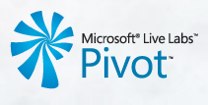
At Microsoft's PDC event a few weeks ago, Microsoft Live Labs introduced a new technology, called Pivot, to make sense of interconnectedness between objects on the web. The underlying premise of Pivot is to view relationships between "collections" of individual information on the the web. Many of the connections between items on the web aren't necessarily tangible, but Pivot helps crawl massive amount of objects on the web and produces sleek visualizations of all that is connected. We sat down with Microsoft developer Gary Flake, who created Pivot, and Microsoft evangelist Brandon Watson to take an in-depth look at the application. While Pivot is currently in private beta, we have 500 invites for TechCrunch readers who use the code "16FC 2946 0C4C 4CCB" when downloading the app here.
Pivot is itself a standalone application, but it relies heavily on Internet Explorer's rendering engine. The best way to understand the importance of Pivot is through a real-world example of how this technology would work. So let's say I wanted a visualization of all the Wikipedia links to TechCrunch, Pivot would essentially crawl all of Wikipedia and create a map of the Wikipedia pages that are connected to TechCrunch, such as Michael Arrington's Wikipedia page.


At Microsoft’s PDC event a few weeks ago, Microsoft Live Labs introduced a new technology, called Pivot, to make sense of interconnectedness between objects on the web. The underlying premise of Pivot is to view relationships between “collections” of individual information on the the web. Many of the connections between items on the web aren’t necessarily tangible, but Pivot helps crawl massive amount of objects on the web and produces sleek visualizations of all that is connected. We sat down with Microsoft developer Gary Flake, who created Pivot, and Microsoft evangelist Brandon Watson to take an in-depth look at the application. While Pivot is currently in private beta, we have 500 invites for TechCrunch readers who use the code “16FC 2946 0C4C 4CCB” when downloading the app here.
Pivot is itself a standalone application, but it relies heavily on Internet Explorer’s rendering engine. The best way to understand the importance of Pivot is through a real-world example of how this technology would work. So let’s say I wanted a visualization of all the Wikipedia links to TechCrunch, Pivot would essentially crawl all of Wikipedia and create a map of the Wikipedia pages that are connected to TechCrunch, such as Michael Arrington’s Wikipedia page.
Another real-world use of Pivot is extracting data from Facebook. For example, you can use Pivot to crawl Facebook and break down friends by various data points like relationship status or college. Microsoft has an interesting example of Pivot being used to sort through Sports Illustrated covers, where you can break down covers into verticals by type of sport, team, athlete and more.
On the backend, Pivot is a rich media application that is built on top of the .NET framework and is powered by C Dragon, which also is integrated with parts of Silverlight, Microsoft’s version of Flash. C Dragon contributes to the advanced zooming and movable interface of Pivot. The application also includes an Excel plug-in that lets you import data into Pivot.
When turned on, Pivot can also make sense of your own browsing history (if you are using Internet Explorer). Pivot hosts a portion of IE within the app, and will get a sense of your browsing history over time and then will slice and dice your history based upon various verticals. You could even integrate Pivot with our own data base CrunchBase so users can visually break down all of the data within the site.
Pivot is definitely a cool toy to play around with and its scalability and results are impressive. Not only does it allow for deep-data dives from the web, but its visualizations are sleek and the rich-media features from C Dragon make the app easy to navigate.
Pivot isn’t the first compelling technology to come out of Microsoft’s Live Labs. Photosynth, a graduate of Live Labs, is an impressive photo viewing project that stiches together images to create pseudo-3D worlds.
Here’s a nifty screencast of how one developer used Pivot to mine data from Facebook:
Crunch Network: CrunchBase the free database of technology companies, people, and investors


Comments
Post a Comment